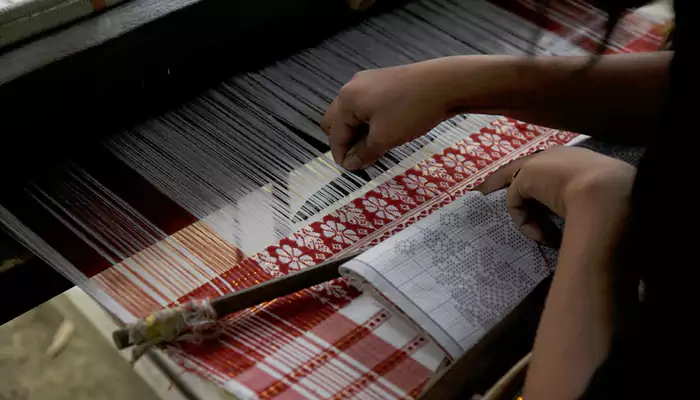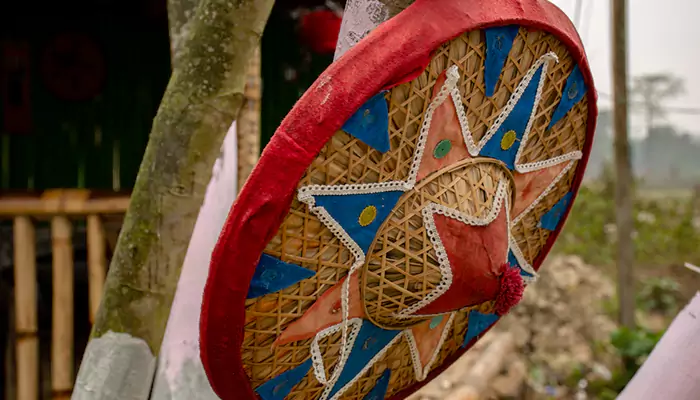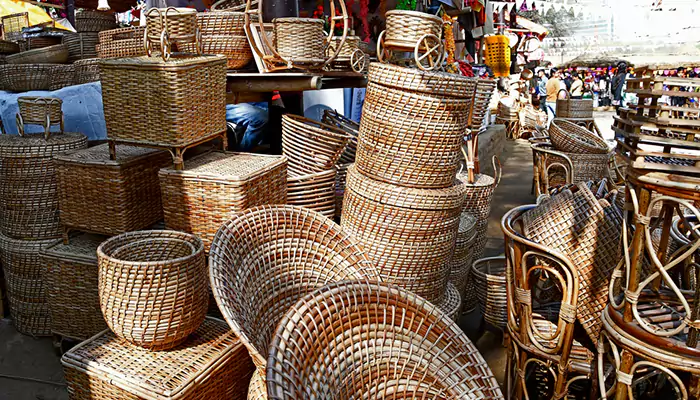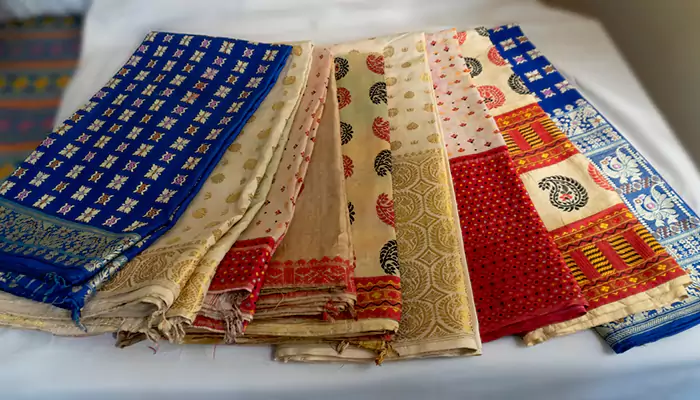
Bihu isn’t just a festival—it’s a celebration of culture, and its handicrafts like gamosas and jaapis are the unsung heroes. Let’s dive into the vibrant world of Bihu handicrafts and discover the artistry behind these beautiful symbols!
Bohag Bihu, Assam’s most vibrant festival, is a riot of colors, dance, and music. But beyond the feasts and the energetic Bihu dances, there’s something equally special—the stunning handicrafts that define this celebration. From the humble gamosa to the elegant jaapi, these crafts aren’t just decorative; they’re woven with tradition, love, and cultural pride.
So, let’s take a closer look at these beautiful creations and the hands that make them!

If you’ve ever been to a Bihu celebration, you’ve definitely seen the gamosa—the iconic white and red cotton towel that’s everywhere. But here’s the thing: it’s not just a towel. It’s a symbol of respect, warmth, and Assamese hospitality.
Handwoven by skilled artisans, gamosas are traditionally made of cotton or sometimes silk. The red motifs (usually floral or geometric) on a white background aren’t just random designs—they carry cultural significance, often representing prosperity and joy.
What’s fascinating is that no two gamosas are exactly alike. Weavers add their personal touch, making each piece unique. And while machine-made versions exist today, nothing beats the charm of a handwoven gamosa.
During Bihu, gamosas are everywhere—draped around dancers’ necks, gifted to elders as a sign of respect, or even used to adorn the Bihuwan (the traditional attire). It’s not just fabric; it’s emotion woven into threads.

Now, let’s talk about the jaapi—the gorgeous, circular bamboo hat that’s as practical as it is beautiful. Originally used by farmers to shield themselves from the sun and rain, the jaapi has become a cultural emblem, especially during Bihu.
Made from bamboo and dried tokou paat (palm leaves), jaapis are a marvel of craftsmanship. Artisans carefully weave the bamboo into a sturdy frame, then layer it with palm leaves for that signature conical shape.
The more decorative ones—used in festivals and weddings—are adorned with colorful patterns, mirrors, and even intricate Assamese motifs. Some are so elaborate that they’re considered works of art rather than just headgear!
During Bohag Bihu, jaapis often take center stage. You’ll see them hanging as decorations, gifted to guests, or even worn during performances. They symbolize not just tradition but also the hardworking spirit of Assam’s farmers.
While gamosas and jaapis are the stars, there are other beautiful crafts that add charm to Bihu celebrations:
These bell-metal trays and stands are used to offer pan (betel nut) and tamul (betel leaves) to guests, a traditional Assamese gesture of welcome.

From baskets to decorative items, Assamese artisans create stunning utility pieces that reflect the state’s rich bamboo heritage.

Though not exclusive to Bihu, these traditional sarees are often worn during the festival, showcasing exquisite Assamese weaving.
In a world of mass-produced goods, Bihu handicrafts stand out because they’re made with patience, skill, and a deep connection to culture. Every gamosa, every jaapi tells a story—of the weaver’s dedication, of Assam’s agrarian roots, and of a festival that brings people together.
Plus, supporting these artisans helps keep these traditions alive. So next time you see a gamosa or a jaapi, remember—it’s not just an object; it’s a piece of Assam’s heart.
Bohag Bihu is a time of joy, and its handicrafts add so much beauty to the celebrations. Whether it’s the warmth of a gamosa or the rustic elegance of a jaapi, these crafts are more than just accessories—they’re cultural treasures.
So, this Bihu, take a moment to appreciate the artistry behind them. Who knows? You might just fall in love with Assam’s handicrafts as much as its festivals! Happy Bihu, and may your celebrations be as vibrant as a handwoven gamosa!